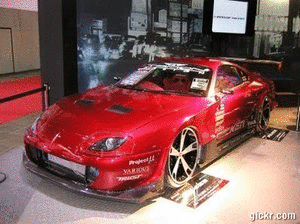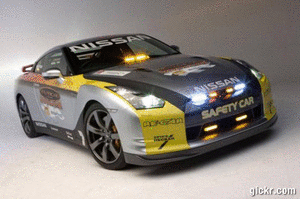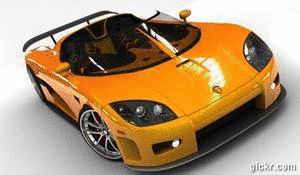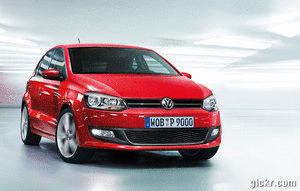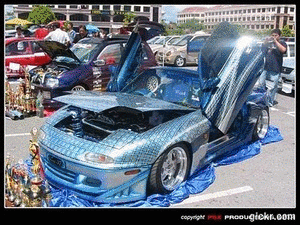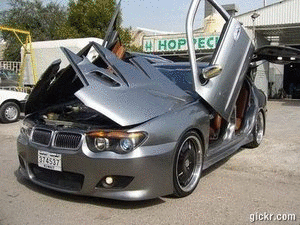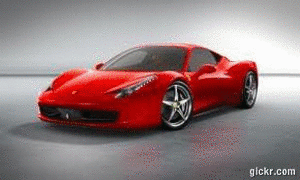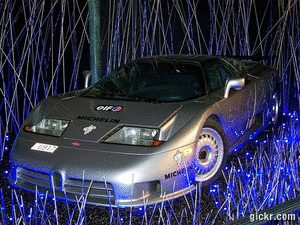Most vehicles have ignition systems and a throttle bore. The vehicle's ignition system is the component that ignites the fuel air mixture inside the combustion chamber. When an ignition system fails, it can cause various symptoms such as stalling, rough engine under power, service engine light (check engine) and complete engine shut down. Be sure to keep your vehicle's engine and fuel system clean to assure the proper operation of your vehicle. The step by step instruction below is characteristic of today's ignition and air intake systems. Most vehicles today need a tune up every 35,000 to 65,000 miles depending on driving conditions. Before starting determine which tune up parts are needed. Inspect the particular system on your car or truck then purchase the appropriate parts to complete the job.
READ COMPLETELY BEFORE STARTING!
Step 1 - Identify Throttle Bore (air intake plate and bore)
Cleaned Throttle Body
Most vehicles have an air intake system that will become clogged with air contaminants that the air filter cannot keep out of the system. This condition is called "coking" and can cause stalling as well as variable idle condition and poor mileage. The throttle bore in this illustration has been cleaned for visual purposes. Usually the throttle bore and plate are coated with a dark light tar that needs to be cleaned with every tune up.
Step 2 - Cleaning the Throttle Bore and Throttle Plate (air intake plate and bore)
Most vehicles have a throttle cable that can be held open to help with the cleaning procedure. Open the throttle bore and with a cleaning towel and cleaner, (rubbing alcohol works well) continue cleaning until the throttle bore and plate are clean.
Step 3 - Identify Tune Up Components
Most vehicles have two kinds of ignition systems. The first is DIS (distributor less ignition system) and COS (coil over spark plug) no spark plug wires. If you can't identify which system you have, follow this link to get the right system for your car (car repair manuals). Confirm your vehicle to determine the tune up parts needed. A typical tune up includes spark plugs, air filter, fuel filter, spark plug wires, distributor cap and ignition rotor. You must determine which parts are needed before you start.
Step 4 - Remove Plug Wire Retainer Guide
Remove the spark plug wires retainer clip(s). These are important in keeping the plug wires separated and controlled to avoid any contact with undesirable components (exhaust manifold, drive belts etc). Clean and inspect the spark plug wire separators for reinstallation.
Step 5 - Remove Plug Wires
Remove the spark plug boot end and twist the boot to break the airtight seal created round the plug wire boot. Then gently pull the spark plug wire from the spark plug. Remove the plug wire from the coil terminal. It is important to change the spark plugs and wires ONE AT A TIME to make sure you don't get the wires mixed up.
Step 6 - Matching to Replace Plug Wires
Remove all plug wires from the packaging, straighten them out and organize the plug wires from largest to shortest. Match up spark plug wires by length and reinstall one at a time.
Step 7 - Remove Spark Plug
Next, remove debris from the spark plug hole, (canned air works best) then use a socket wrench and spark plug socket to loosen and remove spark plug (counter clockwise). Inspect spark plug for damage.
Step 8 - Replace Spark Plug
Remove the spark plug from the box or container and inspect the new plug for damage that could have occurred in shipping. A spark plug has a porcelain isolator that is fragile and can crack easily. Next inspect the spark plug gap using a spark plug gap checker. The "air gap" should be measured as per manufacturer specifications. Most plug gaps are between .035 and .045 thousands of an inch. This gap is important because it determines the amount of resistance used to "time" the system. An incorrect spark plug gap will result in poor running, low power, poor mileage and a check engine light notice. Reinstall the spark plug and install the new spark plug wire. Most of the time a spark plug will come "pre-set" and ready to install. Continue the process until all spark plugs and spark plug wires have been replaced. Be sure to use OE (original equipment) parts for your car to insure the proper performance from your vehicle. This tutorial has outlined a tune up on a gasoline power engine, four cylinder 1995 Saturn SL1. Most gasoline powered cars and trucks are similar.
|
|
|---|
Alternator and Charging System
A battery is needed to power the operating system of your car. Once the vehicle is running an alternator that is driven by the engine charges the battery. While in operation the alternator creates electricity, about 13.6 to 14.3 volts, and recharges the battery to its original state of charge. The alternator is one of the hardest working electrical components in your vehicle. When your vehicle is running the alternator is busy creating electricity to provide the engine and the car accessories with needed power. When the car is not running and your battery is severely discharged some electrical components such as alarms or other memory retaining items may still operate or operate poorly. Typically, these components are designed to operate properly at 12 volts; if the system voltage is low it can cause erratic symptoms.
Common Problems and Solutions
When jump-started a severely discharged battery can cause the alternator to overload and internally fail. If this occurs replace or charge the battery before replacing the alternator. This will help prevent a second alternator failure. Most vehicles use a multi-ribbed belt connected to the engine to rotate the armature inside the alternator. If the belt fails it should be replaced immediately. Belt tension should be taught. If it isn't, check the belt tensioner, it may need to be replaced or the incorrect size belt may have been installed. Either of these conditions can cause the vehicle to stall and not restart.
Additionally, problems can occur if the alternator is overcharging the system. Some symptoms of overcharging include a swollen or seeping battery, both headlight bulbs failing at the same time, and other electrical component problems. To perform an alternator system check for this condition use a voltmeter on both positive and negative terminals while the engine is idling. If the voltmeter reading is over 15 volts this is an indication of an overcharging alternator. The alternator should be replaced with an OE (original equipment) unit. While an inferior rebuilt alternator is often much cheaper, it can fail prematurely causing another costly replacement.
The most common alternator problem is "undercharging." This condition is often accompanied by symptoms such as a low state of charge on the battery, poor or erratic performance from electrical components and dim headlights and other lighting systems. The first symptom of an undercharging alternator is a slow cranking engine. The next symptom is a "machine gun" sound when the engine is cranked as the system voltage drops below normal operating levels. In order to correct this problem a replacement alternator must be installed after the battery has been replaced or charged.
Maintenance
To ensure that your alternator lasts as long as possible there are several things you can do. Be sure all battery connections are tight and both terminals are clean. This should be inspected periodically regardless of when the battery was changed as even new batteries can have problems and be defective. While the engine is off, visually inspect the alternator belt and replace the belt if cracks or tears are observed.
Common Problems and Solutions
When jump-started a severely discharged battery can cause the alternator to overload and internally fail. If this occurs replace or charge the battery before replacing the alternator. This will help prevent a second alternator failure. Most vehicles use a multi-ribbed belt connected to the engine to rotate the armature inside the alternator. If the belt fails it should be replaced immediately. Belt tension should be taught. If it isn't, check the belt tensioner, it may need to be replaced or the incorrect size belt may have been installed. Either of these conditions can cause the vehicle to stall and not restart.
Additionally, problems can occur if the alternator is overcharging the system. Some symptoms of overcharging include a swollen or seeping battery, both headlight bulbs failing at the same time, and other electrical component problems. To perform an alternator system check for this condition use a voltmeter on both positive and negative terminals while the engine is idling. If the voltmeter reading is over 15 volts this is an indication of an overcharging alternator. The alternator should be replaced with an OE (original equipment) unit. While an inferior rebuilt alternator is often much cheaper, it can fail prematurely causing another costly replacement.
The most common alternator problem is "undercharging." This condition is often accompanied by symptoms such as a low state of charge on the battery, poor or erratic performance from electrical components and dim headlights and other lighting systems. The first symptom of an undercharging alternator is a slow cranking engine. The next symptom is a "machine gun" sound when the engine is cranked as the system voltage drops below normal operating levels. In order to correct this problem a replacement alternator must be installed after the battery has been replaced or charged.
Maintenance
To ensure that your alternator lasts as long as possible there are several things you can do. Be sure all battery connections are tight and both terminals are clean. This should be inspected periodically regardless of when the battery was changed as even new batteries can have problems and be defective. While the engine is off, visually inspect the alternator belt and replace the belt if cracks or tears are observed.
Hybrid Battery/Charge/Braking Information
Introduction:
Hybrid batteries are responsible for supplying electrical power to the electric motor and the remaining accessories of the vehicle such as the air conditioner and the lighting system. The technology responsible for today's battery advancements have been the result of millions of dollars in research funding. Because of these advancements additional goals of auto manufacturers can be realized. One obstacle battery manufacturers have had is the ability to quickly recharge the battery. In the past if the battery was charged too fast it could explode or catch fire. Additionally, the rate in which the battery was charged at has directly relegated to how long the charge would last. Lithium-ion batteries addressed this issue by allowing accelerated rate of charging with limited damage to the battery.
Hybrid Battery Cut-away
The internal parts of the hybrid battery consist of many smaller cells connected together with an electrical framework. This framework determines which batteries to use and charge depending on the "state of charge" of the cell. Lithium-ion batteries have enabled manufacturers to achieve long awaited goals for battery charge rate and power output capabilities. Even the "lifetime" of these batteries has been extended mainly because in the shift from using lead to copper for the battery contents.
The charging system for the hybrid car is a combination between the combustion engine alternator, regenerative brake system or a "plug in" from an outside source.
Hybrid batteries are responsible for supplying electrical power to the electric motor and the remaining accessories of the vehicle such as the air conditioner and the lighting system. The technology responsible for today's battery advancements have been the result of millions of dollars in research funding. Because of these advancements additional goals of auto manufacturers can be realized. One obstacle battery manufacturers have had is the ability to quickly recharge the battery. In the past if the battery was charged too fast it could explode or catch fire. Additionally, the rate in which the battery was charged at has directly relegated to how long the charge would last. Lithium-ion batteries addressed this issue by allowing accelerated rate of charging with limited damage to the battery.
Hybrid Battery Cut-away
The internal parts of the hybrid battery consist of many smaller cells connected together with an electrical framework. This framework determines which batteries to use and charge depending on the "state of charge" of the cell. Lithium-ion batteries have enabled manufacturers to achieve long awaited goals for battery charge rate and power output capabilities. Even the "lifetime" of these batteries has been extended mainly because in the shift from using lead to copper for the battery contents.
The charging system for the hybrid car is a combination between the combustion engine alternator, regenerative brake system or a "plug in" from an outside source.
Hybrid Engine/Motor/Drivetrain Information Part 2
Introduction:
Hybrid engines vary greatly between manufacturers even thought the theory is pretty much the same. Take an efficient petroleum based engine and couple it with a high output electric motor. Additionally design an operating system that can choose the most efficient power source to use depending on the vehicles situation. A gasoline engine
is more efficient at higher engine speeds, while the electric engine is more usable at low rpm. To determine which engine is to be used an integrated computer system is used to control all aspects of the power switch. In most cases the electric motor will start the car in motion, and then when it gets to cruising speed the combustion engine propels the vehicle. If the vehicle is designed with regenerative brakes it means when the brake are applied a progressive variable generator system is engaged. In some hybrids this generator effect is created by changing the electric motor current flow to produce electric power instead of consuming it. By controlling this generating action a user can vary the resistance via the brake pedal
creating more or less resistance.
Ford Hybrid Motor
The hybrid electric motor can vary depending on design. The ford Hybrid engine above is integrated into the transmission and is wide and stout. While the Honda hybrid engine (below) is thin and has a larger circumference and is located between the engine and transmission.
Honda Hybrid Motor
Hybrid transmission can vary also, the transmissions below works by centrifugal force, the faster the wheels spin the higher the gear ratio. Hybrid cars also have conventional 4 or 5 speed style of transmissions. The torque converter has been replaced by an electrically controlled coupler that can be engaged and disengaged. The electric motor has engine has three modes:
* Power Mode - This mode is used to propel the car forward. The motor timing is controlled to produce the most power for a particular application such as an aggressive take off versus a moderate acceleration mode.
* Free-Wheel Mode - This motor mode is used while the car is utilizing the internal combustion engine.
* Braking Mode - This mode is used while the brakes are applied. The car is slowed by causing the electric motor to produce electrical power.
Hybrid Engine Transmission
Hybrid Trans Cut Away
Hybrid engines vary greatly between manufacturers even thought the theory is pretty much the same. Take an efficient petroleum based engine and couple it with a high output electric motor. Additionally design an operating system that can choose the most efficient power source to use depending on the vehicles situation. A gasoline engine
is more efficient at higher engine speeds, while the electric engine is more usable at low rpm. To determine which engine is to be used an integrated computer system is used to control all aspects of the power switch. In most cases the electric motor will start the car in motion, and then when it gets to cruising speed the combustion engine propels the vehicle. If the vehicle is designed with regenerative brakes it means when the brake are applied a progressive variable generator system is engaged. In some hybrids this generator effect is created by changing the electric motor current flow to produce electric power instead of consuming it. By controlling this generating action a user can vary the resistance via the brake pedal
creating more or less resistance.
Ford Hybrid Motor
The hybrid electric motor can vary depending on design. The ford Hybrid engine above is integrated into the transmission and is wide and stout. While the Honda hybrid engine (below) is thin and has a larger circumference and is located between the engine and transmission.
Honda Hybrid Motor
Hybrid transmission can vary also, the transmissions below works by centrifugal force, the faster the wheels spin the higher the gear ratio. Hybrid cars also have conventional 4 or 5 speed style of transmissions. The torque converter has been replaced by an electrically controlled coupler that can be engaged and disengaged. The electric motor has engine has three modes:
* Power Mode - This mode is used to propel the car forward. The motor timing is controlled to produce the most power for a particular application such as an aggressive take off versus a moderate acceleration mode.
* Free-Wheel Mode - This motor mode is used while the car is utilizing the internal combustion engine.
* Braking Mode - This mode is used while the brakes are applied. The car is slowed by causing the electric motor to produce electrical power.
Hybrid Engine Transmission
Hybrid Trans Cut Away
Information On Hybrid Technology Part 1
Introduction:
Hybrid cars and trucks
are becoming more popular as petroleum based fuels have become more expense to obtain as the world supply diminishes. As technology improves on both the efficiency of the rechargeable battery packs and the increased motor output hybrids cars have become more feasible. Research in hybrid technology has been extensive and beneficial to extend the range and power aspects. The most noticeable advancements have been in the battery sector. The batteries that power a hybrid vehicle are composed of many cells connected together into "battery packs". These packs can be permanently mounted to the vehicle or designed for easy removal and replacement. The "quick change" design is beneficial for future deployment of "charge stations" that will enable long distance travel by replacing the battery pack within a couple minutes.
Hybrid Car
There is no doubt, the world will run low petroleum fuel sometime in the near future and hybrid/electric vehicles will be the solution. Automakers have taking notice of this forecast and have made changes in the car lineup that will enable them to respond to the new hybrid car demand. This lineup includes new models along with existing models that have been updated with the new hybrid design. A definition of "hybrid" means "more than one source of power" whereas an electric car is fully electrically powered with no alterative power source. A hybrid can be comprised of hydrogen and electric, petroleum fuel and electric and any other combination imaginable. The controller area network (CAN) incorporates high-speed communication busses to facilitate communication between the microprocessors and additional control systems. The multi-layer control system consists of electric motor controllers, battery management systems, transmission controller, engine controller, and electrical the power grid controller. The hybrid systems are more complex when integrated with an anti-lock brake system. Some hybrid system design controls complex systems such as regenerative brakes, main motor electrical power output/backup systems and switching between fuel and electrical power.
This system also controls the more normal aspects of the car such as anti-theft, climate control, window, light operation and entertainment systems. The computer system is separated into modules and connects via an information bus. As in most computer systems an automatic malfunction detection program is designed to alert the driver a malfunction has occurred. Once this system MIL (malfunction inductor lamp) has illuminated a diagnostic trouble code will be stored in the vehicle's computer and can be retrieved much like a fully petroleum based fuel car would. The method of code retrieval can vary from a self initiated request to a serial port design to allow a code reader or a lap top with a specific program to retrieve the trouble codes. Even though it true hybrid cars and trucks have less maintenance, the maintenance and service they do need will be more expensive. One of the largest maintenance items that will need little service compared to regular petroleum fuel car is the brake system. Because a hybrid's brake system is regenerative the energy normally lost in the brake process is now directed to the batteries in the form of electricity. Brake systems for conventional petroleum based cars utilize a hydraulic pressure system that creates friction via brake pads, shoes, drums and rotors to slow the vehicle. This action creates heat generated from the linear motion of a brake rotor or drum. This heat/friction energy is recovered in a regenerative braking system.
To increase range capabilities for the hybrid car an auxiliary battery pack can be installed on some models to help increase battery life. These extras battery packs are designed to boost the current system as a supplemental electric supply. Extended life batteries can be charged separately and carried onboard to increase travel distance. Additionally, after market battery manufactures have produced "extra life" main battery packs designed to replace the original battery pack. Some companies claim to have improved battery life more than 100 miles to the vehicle range.
Hybrid Car Advancement Categories
* Weight Reduction
* Aerodynamics
* Lubrication Systems
* Wheels and Tires/Rolling Resistance
* Optical Systems
The body of the hybrid car is lighter than a conventional vehicle thus facilitating higher mileage. The tires are made of firm material and hold more air pressure to decrease drag. The batteries are charged by recovering brake energy (kinetic) and are recharged. Unlike the batteries of a conventional car the battery of a hybrid car differs in the internal structure and the amount of energy stored. The replacement of nickel with copper has made the hybrid battery more powerful but the cost is rising do to the increased demand of raw materials. A battery called a lithium ion is quickly becoming a viable alternative. They can produce more power with a shorter recharge rate.

A lightweight lithium ion battery also provides more power and a longer running time than copper based batteries. This increases the efficiency and acceleration of the car. The biggest advantage to users will be when lithium batteries are mass produced to hold down the cost. Some hybrid cars are now being produce have the option of "plug-in to charge" batteries. The user will plug in the vehicle to a conventional electrical outlet to charge. This technology is a major advancement and requires robust battery technology and an intelligent computer control system.

Toyota Hybrid Motorium ion batteries have cobalt oxide cathode material, which makes it more vulnerable to catch fire or explode. This is known as the thermal runaway effect. To defeat this condition manufacturers have now replaced the cobalt metal with phosphate. This provides the same charging power and energy storage when compared to cobalt oxide battery.
Scientists claim that the modern nickel metal hydride batteries, when compared to the traditional nickel cadmium and lead acid batteries cause less harm to the environment. Lead batteries are the most toxic followed by nickel and then lithium. Most manufacturers recycle many of the components of the battery. The parts are disassembled and divided into categories, plastic is shredded, metals and fluid extracted. The remainder of the contents is neutralized before it is sent into landfills.
Hybrid cars and trucks
are becoming more popular as petroleum based fuels have become more expense to obtain as the world supply diminishes. As technology improves on both the efficiency of the rechargeable battery packs and the increased motor output hybrids cars have become more feasible. Research in hybrid technology has been extensive and beneficial to extend the range and power aspects. The most noticeable advancements have been in the battery sector. The batteries that power a hybrid vehicle are composed of many cells connected together into "battery packs". These packs can be permanently mounted to the vehicle or designed for easy removal and replacement. The "quick change" design is beneficial for future deployment of "charge stations" that will enable long distance travel by replacing the battery pack within a couple minutes.
Hybrid Car
There is no doubt, the world will run low petroleum fuel sometime in the near future and hybrid/electric vehicles will be the solution. Automakers have taking notice of this forecast and have made changes in the car lineup that will enable them to respond to the new hybrid car demand. This lineup includes new models along with existing models that have been updated with the new hybrid design. A definition of "hybrid" means "more than one source of power" whereas an electric car is fully electrically powered with no alterative power source. A hybrid can be comprised of hydrogen and electric, petroleum fuel and electric and any other combination imaginable. The controller area network (CAN) incorporates high-speed communication busses to facilitate communication between the microprocessors and additional control systems. The multi-layer control system consists of electric motor controllers, battery management systems, transmission controller, engine controller, and electrical the power grid controller. The hybrid systems are more complex when integrated with an anti-lock brake system. Some hybrid system design controls complex systems such as regenerative brakes, main motor electrical power output/backup systems and switching between fuel and electrical power.
This system also controls the more normal aspects of the car such as anti-theft, climate control, window, light operation and entertainment systems. The computer system is separated into modules and connects via an information bus. As in most computer systems an automatic malfunction detection program is designed to alert the driver a malfunction has occurred. Once this system MIL (malfunction inductor lamp) has illuminated a diagnostic trouble code will be stored in the vehicle's computer and can be retrieved much like a fully petroleum based fuel car would. The method of code retrieval can vary from a self initiated request to a serial port design to allow a code reader or a lap top with a specific program to retrieve the trouble codes. Even though it true hybrid cars and trucks have less maintenance, the maintenance and service they do need will be more expensive. One of the largest maintenance items that will need little service compared to regular petroleum fuel car is the brake system. Because a hybrid's brake system is regenerative the energy normally lost in the brake process is now directed to the batteries in the form of electricity. Brake systems for conventional petroleum based cars utilize a hydraulic pressure system that creates friction via brake pads, shoes, drums and rotors to slow the vehicle. This action creates heat generated from the linear motion of a brake rotor or drum. This heat/friction energy is recovered in a regenerative braking system.
To increase range capabilities for the hybrid car an auxiliary battery pack can be installed on some models to help increase battery life. These extras battery packs are designed to boost the current system as a supplemental electric supply. Extended life batteries can be charged separately and carried onboard to increase travel distance. Additionally, after market battery manufactures have produced "extra life" main battery packs designed to replace the original battery pack. Some companies claim to have improved battery life more than 100 miles to the vehicle range.
Hybrid Car Advancement Categories
* Weight Reduction
* Aerodynamics
* Lubrication Systems
* Wheels and Tires/Rolling Resistance
* Optical Systems
The body of the hybrid car is lighter than a conventional vehicle thus facilitating higher mileage. The tires are made of firm material and hold more air pressure to decrease drag. The batteries are charged by recovering brake energy (kinetic) and are recharged. Unlike the batteries of a conventional car the battery of a hybrid car differs in the internal structure and the amount of energy stored. The replacement of nickel with copper has made the hybrid battery more powerful but the cost is rising do to the increased demand of raw materials. A battery called a lithium ion is quickly becoming a viable alternative. They can produce more power with a shorter recharge rate.

A lightweight lithium ion battery also provides more power and a longer running time than copper based batteries. This increases the efficiency and acceleration of the car. The biggest advantage to users will be when lithium batteries are mass produced to hold down the cost. Some hybrid cars are now being produce have the option of "plug-in to charge" batteries. The user will plug in the vehicle to a conventional electrical outlet to charge. This technology is a major advancement and requires robust battery technology and an intelligent computer control system.

Toyota Hybrid Motorium ion batteries have cobalt oxide cathode material, which makes it more vulnerable to catch fire or explode. This is known as the thermal runaway effect. To defeat this condition manufacturers have now replaced the cobalt metal with phosphate. This provides the same charging power and energy storage when compared to cobalt oxide battery.
Scientists claim that the modern nickel metal hydride batteries, when compared to the traditional nickel cadmium and lead acid batteries cause less harm to the environment. Lead batteries are the most toxic followed by nickel and then lithium. Most manufacturers recycle many of the components of the battery. The parts are disassembled and divided into categories, plastic is shredded, metals and fluid extracted. The remainder of the contents is neutralized before it is sent into landfills.
How a Oxygen Sensor Works?
The oxygen sensor in your vehicle is an electronic component that is designed to measure levels of oxygen in the engine exhaust. Typically, the oxygen sensor is mounted to the exhaust system tube, with the sensor part inside the tube. This measures the oxygen mixture by generating a small amount of electricity due to the difference in atmosphere, oxygen and carbon dioxide. The PCM monitors this voltage and adjusts the fuel system and engine timing accordingly.
The oxygen sensor is in continuous communication with the engine control unit giving it the information necessary to adjust fuel intake and ignition timing for correct combustion. When the engine is cold the oxygen sensor is not as active, but will become so after the engine coolant has reached a specific temperature. Early sensors used this time to “heat” up so that the reactive material within could work properly, to correct this condition the oxygen sensor has been constructed with a 12 volt heater element. This heater allows the sensor to read at maximum efficiency quicker. When the throttle is wide open and under max load the oxygen sensor will go full voltage until normal operating conditions return. Typically changing an oxygen sensor when necessary is a simple process. Most solutions to oxygen sensor problems result in changing the oxygen sensor, but always be sure there are no vacuum leaks present in the intake
system, this can give a false oxygen sensor trouble code Due to the severe usage the sensor endures, it is common for most sensors to last approximately 75,000 miles, however it is not uncommon for an oxygen sensor to last only 40,000 miles depending on your driving habits and vehicle conditions.
 Oxygen Sensor Cut Away
Oxygen Sensor Cut Away
Over the life of the oxygen sensor soot build up can occur on the sensing probe which can result in inaccurate readings. This can cause your engine to run rough and consume excessive fuel. Remove the sensor and replace it with a new sensor.
The oxygen sensor is in continuous communication with the engine control unit giving it the information necessary to adjust fuel intake and ignition timing for correct combustion. When the engine is cold the oxygen sensor is not as active, but will become so after the engine coolant has reached a specific temperature. Early sensors used this time to “heat” up so that the reactive material within could work properly, to correct this condition the oxygen sensor has been constructed with a 12 volt heater element. This heater allows the sensor to read at maximum efficiency quicker. When the throttle is wide open and under max load the oxygen sensor will go full voltage until normal operating conditions return. Typically changing an oxygen sensor when necessary is a simple process. Most solutions to oxygen sensor problems result in changing the oxygen sensor, but always be sure there are no vacuum leaks present in the intake
system, this can give a false oxygen sensor trouble code Due to the severe usage the sensor endures, it is common for most sensors to last approximately 75,000 miles, however it is not uncommon for an oxygen sensor to last only 40,000 miles depending on your driving habits and vehicle conditions.
 Oxygen Sensor Cut Away
Oxygen Sensor Cut AwayOver the life of the oxygen sensor soot build up can occur on the sensing probe which can result in inaccurate readings. This can cause your engine to run rough and consume excessive fuel. Remove the sensor and replace it with a new sensor.
Subscribe to:
Comments (Atom)
